Experimental Investigation on the Impact of Varying Air-Inlet Widths and Fuel Pan Diameters on Fire Whirls’ Combustion Characteristics
Abstract
1. Introduction
2. Materials and Methods
3. Results and Discussion
3.1. Intermittent Flame Profile and Morphology
3.2. Burning Rate
3.3. Temperature Distribution
3.4. Evolutionary Pattern of Flame Height
- These three dimensionless parameters of flame height (maximum, average, continuous) each have a power-law relationship with the dimensionless heat release rate (), denoting the primary control mechanism of a three-dimensional axially symmetrical flame whirl [39,40]. This aligns with the correlation between flame height and heat release rate as proposed by Sun [41]. The distribution of the continuous and maximum flame heights near the fitting curve appears more discrete than the average flame height, potentially due to the flame’s periodic fluctuations, leading to certain measurement errors.
- Considering different flame height ratios, the maximum-to-average flame height ratio is approximately 1.35 (), and the average-to-continuous flame height ratio rounds to 1.5 (). Both of these ratios remain unaffected by factors such as the air-inlet width, fuel pan diameter, ambient temperature, and the fire whirl’s heat release rate.
4. Conclusions
- Fire whirl flame height exhibits a negative correlation with air-inlet width and a positive correlation with fuel pan diameter;
- The entire combustion process of a fire whirl can be divided into four phases: free evaporation, transition, quasi-steady-state combustion, and decay. As the air-inlet width incrementally expands, the fire whirl’s burning rate in the quasi-steady-state combustion stage demonstrates an initial increase, followed by a decrease, peaking at an air-inlet width of 7 cm;
- A fire whirl also consists of a continuous flame zone, an intermittent flame zone, and a plume zone, where the dimensionless flame height adheres to the corresponding power-law relationship with the excess temperature. The fire whirl’s continuous flames can comprise up to 55% of the total flames, a notable “stretch” compared to a buoyant pool fire of identical size;
- The 2/5th power of the fire whirl’s dimensionless heat release rate maintains a positive correlation with the dimensionless flame height. The ratio of maximum to average flame height is approximately 1.35, and the ratio of average to continuous flame height is about 1.5. Both ratios remain unaffected by variables such as air-inlet width, fuel pan diameter, ambient temperature, and fire whirl combustion heat release rate.
Author Contributions
Funding
Institutional Review Board Statement
Informed Consent Statement
Data Availability Statement
Conflicts of Interest
References
- Soma, S.; Saito, K. Reconstruction of Fire Whirls Using Scale Models. Combust. Flame 1991, 86, 269–284. [Google Scholar] [CrossRef]
- Tohidi, A.; Gollner, M.J.; Xiao, H. Fire Whirls. Annu. Rev. Fluid Mech. 2018, 50, 187–213. [Google Scholar] [CrossRef]
- Byram, G.M.; Martin, R. The Modeling of Fire Whirlwinds. For. Sci. 1970, 16, 386–399. [Google Scholar] [CrossRef]
- Emmons, H.W.; Ying, S.J. The Fire Whirl. Symp. (Int.) Combust. 1967, 11, 475–488. [Google Scholar] [CrossRef]
- Zhou, K.; Qin, X.; Zhang, L.; Wu, Y. An Experimental Study of Jet Fires in Rotating Flow Fields. Combust. Flame 2019, 210, 193–203. [Google Scholar] [CrossRef]
- Lei, J.; Liu, N.; Jiao, Y.; Zhang, S. Experimental Investigation on Flame Patterns of Buoyant Diffusion Flame in a Large Range of Imposed Circulations. Proc. Combust. Inst. 2017, 36, 3149–3156. [Google Scholar] [CrossRef]
- Liu, Z.; Liu, N.; Lei, J.; Miao, X.; Zhang, L.; Viegas, D.X. Evolution from Conical to Cylindrical Fire Whirl: An Experimental Study. Proc. Combust. Inst. 2021, 38, 4579–4586. [Google Scholar] [CrossRef]
- Ghodrat, M.; Shakeriaski, F.; Nelson, D.J.; Simeoni, A. Experimental and Numerical Analysis of Formation and Flame Precession of Fire Whirls: A Review. Fire 2021, 4, 43. [Google Scholar] [CrossRef]
- Byram, G.M.; Martin, R. Fire Whirlwinds in the Laboratory. Fire Control Notes 1962, 33, 13–17. [Google Scholar]
- Hassan, M.I.; Kuwana, K.; Saito, K.; Wang, F.J. Flow Structure of a Fixed-Frame Type Fire Whirl. Fire Saf. Sci. 2005, 8, 951–962. [Google Scholar] [CrossRef]
- Hayashi, Y.; Kuwana, K.; Dobashi, R. Influence of Vortex Structure on Fire Whirl Behavior. Fire Saf. Sci. 2011, 10, 671–679. [Google Scholar] [CrossRef]
- Kuwana, K.; Morishita, S.; Dobashi, R.; Chuah, K.H.; Saito, K. The Burning Rate’s Effect on the Flame Length of Weak Fire Whirls. Proc. Combust. Inst. 2011, 33, 2425–2432. [Google Scholar] [CrossRef]
- Satoh, K.; Yang, K.T. Experimental Observations of Swriling Fires. Proc. ASME Heat Transf. Div. 1996, 335, 393–397. [Google Scholar]
- Satoh, K.; Yang, K.T. Simulations of Swirling Fires Controlled by Channeled Self-Generated Entrainment Flows. Fire Saf. Sci. 1997, 5, 201–212. [Google Scholar] [CrossRef]
- Lei, J.; Liu, N.; Zhang, L.; Chen, H.; Shu, L.; Chen, P.; Deng, Z.; Zhu, J.; Satoh, K.; de Ris, J.L. Experimental Research on Combustion Dynamics of Medium-Scale Fire Whirl. Proc. Combust. Inst. 2011, 33, 2407–2415. [Google Scholar] [CrossRef]
- Lei, J.; Liu, N.; Tu, R. Flame Height of Turbulent Fire Whirls: A Model Study by Concept of Turbulence Suppression. Proc. Combust. Inst. 2017, 36, 3131–3138. [Google Scholar] [CrossRef]
- Lei, J.; Ji, C.; Liu, N.; Zhang, L. Effect of Imposed Circulation on Temperature and Velocity in General Fire Whirl: An Experimental Investigation. Proc. Combust. Inst. 2019, 37, 4295–4302. [Google Scholar] [CrossRef]
- Lei, J.; Miao, X.; Liu, Z.; Liu, N.; Zhang, L. Lifted Flame in Fire Whirl: An Experimental Investigation. Proc. Combust. Inst. 2021, 38, 4595–4603. [Google Scholar] [CrossRef]
- Lei, J.; Huang, P.; Liu, N.; Zhang, L. On the Flame Width of Turbulent Fire Whirls. Combust. Flame 2022, 244, 112285. [Google Scholar] [CrossRef]
- Chuah, K.H.; Kuwana, K.; Saito, K.; Williams, F.A. Inclined Fire Whirls. Proc. Combust. Inst. 2011, 33, 2417–2424. [Google Scholar] [CrossRef]
- Yu, D.; Zhang, P. On Flame Height of Circulation-Controlled Firewhirls with Variable Physical Properties and in Power-Law Vortices: A Mass-Diffusivity-Ratio Model Correction. Combust. Flame 2017, 182, 36–47. [Google Scholar] [CrossRef]
- Yu, D.; Zhang, P. On the Flame Height of Circulation-Controlled Firewhirls with Variable Density. Proc. Combust. Inst. 2017, 36, 3097–3104. [Google Scholar] [CrossRef]
- Yu, H.; Guo, S.; Peng, M.; Li, Q.; Ruan, J.; Wan, W.; Chen, C. Study on the Influence of Air-Inlet Width on Fire Whirls Combustion Characteristic. Procedia Eng. 2013, 62, 813–820. [Google Scholar] [CrossRef][Green Version]
- Zhang, X.; Hu, L.; Wu, L.; Kostiuk, L.W. Flame Radiation Emission from Pool Fires under the Influence of Cross Airflow and Ambient Pressure. Combust. Flame 2019, 202, 243–251. [Google Scholar] [CrossRef]
- Zhen, H.S.; Leung, C.W.; Cheung, C.S. Thermal and emission characteristics of a turbulent swirling inverse diffusion flame. Int. J. Heat Mass Tran. 2010, 53, 902–909. [Google Scholar] [CrossRef]
- Dong, L.L.; Cheung, C.S.; Leung, C.W. Heat transfer characteristics of an impinging swirling inverse diffusion butane/air flame jet. Exp. Therm. Fluid Sci. 2021, 128, 110438. [Google Scholar] [CrossRef]
- Wang, P.F. Researches on the Flame and Flow Characteristics of Fire Whirls. Ph.D. Thesis, University of Science and Technology of China, Hefei, China, 2015. [Google Scholar]
- Lei, J. Experimental and Theoretical Researches on the Combustion Dynamics of Fire Whirls. Ph.D. Thesis, University of Science and Technology of China, Hefei, China, 2012. [Google Scholar]
- Li, J.; Zeng, Y.; Tao, L.; Liu, Z.; Li, B. Experimental Study on Temperature Decay and Smoke Control in Tunnel Fires with Combination of Multi-Point Smoke Exhaust and Longitudinal Ventilation. Int. J. Therm. Sci. 2023, 183, 107847. [Google Scholar] [CrossRef]
- Orloff, L.; De Ris, J. Froude Modeling of Pool Fires. Symp. (Int.) Combust. 1982, 19, 885–895. [Google Scholar] [CrossRef]
- Quintiere, J.G.; Grove, B.S. A Unified Analysis for Fire Plumes. Symp. (Int.) Combust. 1998, 27, 2757–2766. [Google Scholar] [CrossRef]
- Wan, H.; Gao, Z.; Ji, J.; Wang, L.; Zhang, Y. Experimental Study on Merging Behaviors of Two Identical Buoyant Diffusion Flames under an Unconfined Ceiling with Varying Heights. Proc. Combust. Inst. 2019, 37, 3899–3907. [Google Scholar] [CrossRef]
- Lönnermark, A.; Ingason, H. The Effect of Cross-Sectional Area and Air Velocity on the Conditions in a Tunnel during a Fire; SP Technology Research Institute of Sweden: Borås, Sweden, 2007. [Google Scholar]
- Ji, J.; Wan, H.; Gao, Z.; Fu, Y.; Sun, J.; Zhang, Y.; Li, K.; Hostikka, S. Experimental Study on Flame Merging Behaviors from Two Pool Fires along the Longitudinal Centerline of Model Tunnel with Natural Ventilation. Combust. Flame 2016, 173, 307–318. [Google Scholar] [CrossRef]
- Heskestad, G. Fire Plumes, Flame Height, and Air Entrainment. In SFPE Handbook of Fire Protection Engineering; Springer: Berlin/Heidelberg, Germany, 2016; pp. 396–428. [Google Scholar]
- Mccaffrey, B.J. Purely Buoyant Diffusion Flames: Some Experimental Results; Center for Fire Research National Engineering Laboratory National Bureau of Standards: Washington, DC, USA, 1979. [Google Scholar]
- Lei, J.; Liu, N.; Zhang, L.; Satoh, K. Temperature, Velocity and Air Entrainment of Fire Whirl Plume: A Comprehensive Experimental Investigation. Combust. Flame 2015, 162, 745–758. [Google Scholar] [CrossRef]
- Zukoski, E.E.; Cetegen, B.M.; Kubota, T. Visible Structure of Buoyant Diffusion Flames. Symp. (Int.) Combust. 1985, 20, 361–366. [Google Scholar] [CrossRef]
- Lee, Y.P. Heat Fluxes and Flame Heights on External Facades from Enclosure Fires. Ph.D. Thesis, University of Ulster, Belfast, UK, 2006. [Google Scholar]
- Tang, F.; Hu, L.H.; Delichatsios, M.A.; Lu, K.H.; Zhu, W. Experimental Study on Flame Height and Temperature Profile of Buoyant Window Spill Plume from an Under-Ventilated Compartment Fire. Int. J. Heat Mass Transf. 2012, 55, 93–101. [Google Scholar] [CrossRef]
- Sun, X.; Hu, L.; Zhang, X.; Ren, F.; Yang, Y.; Fang, X. Experimental Study on Flame Pulsation Behavior of External Venting Facade Fire Ejected from Opening of a Compartment. Proc. Combust. Inst. 2021, 38, 4485–4493. [Google Scholar] [CrossRef]


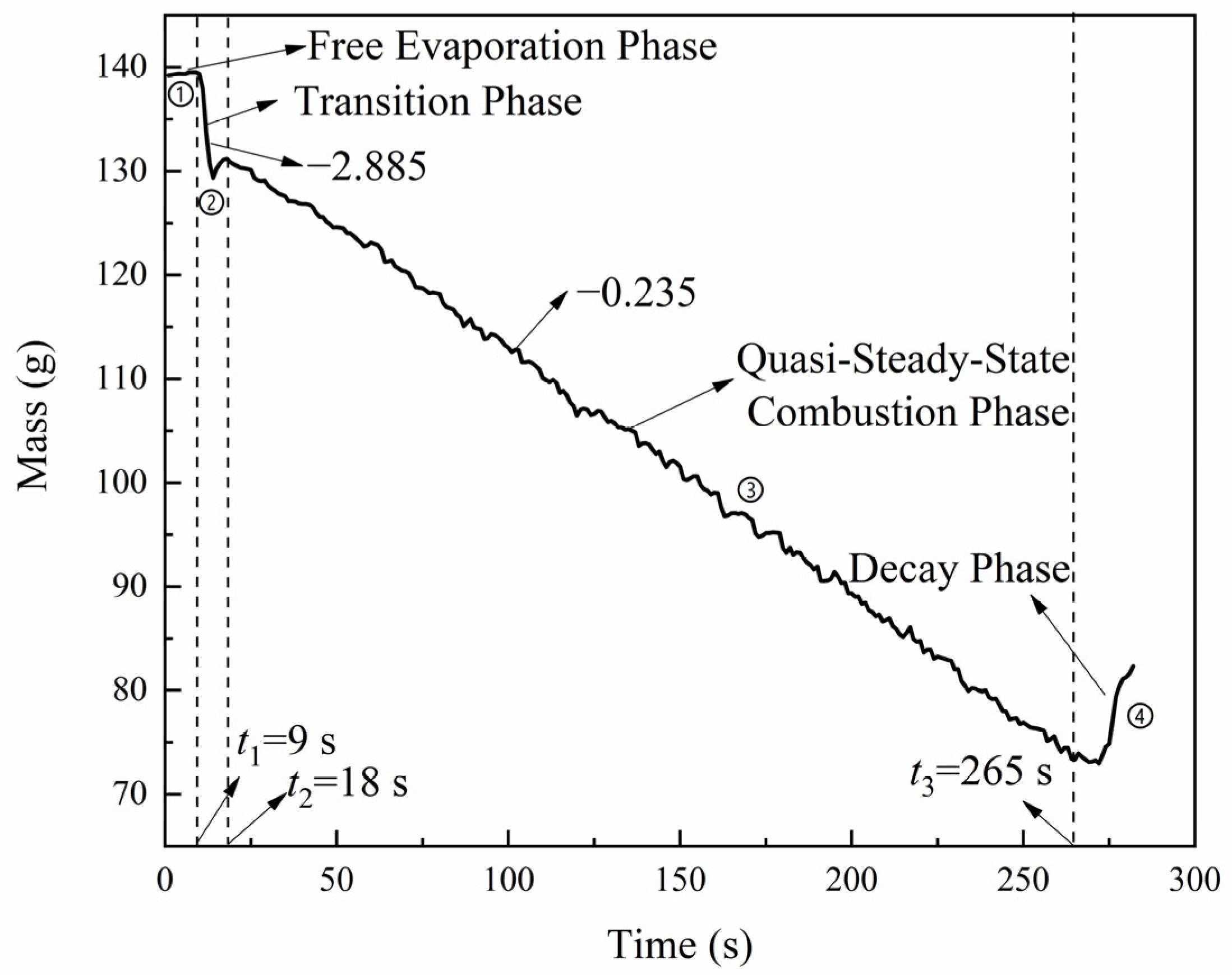
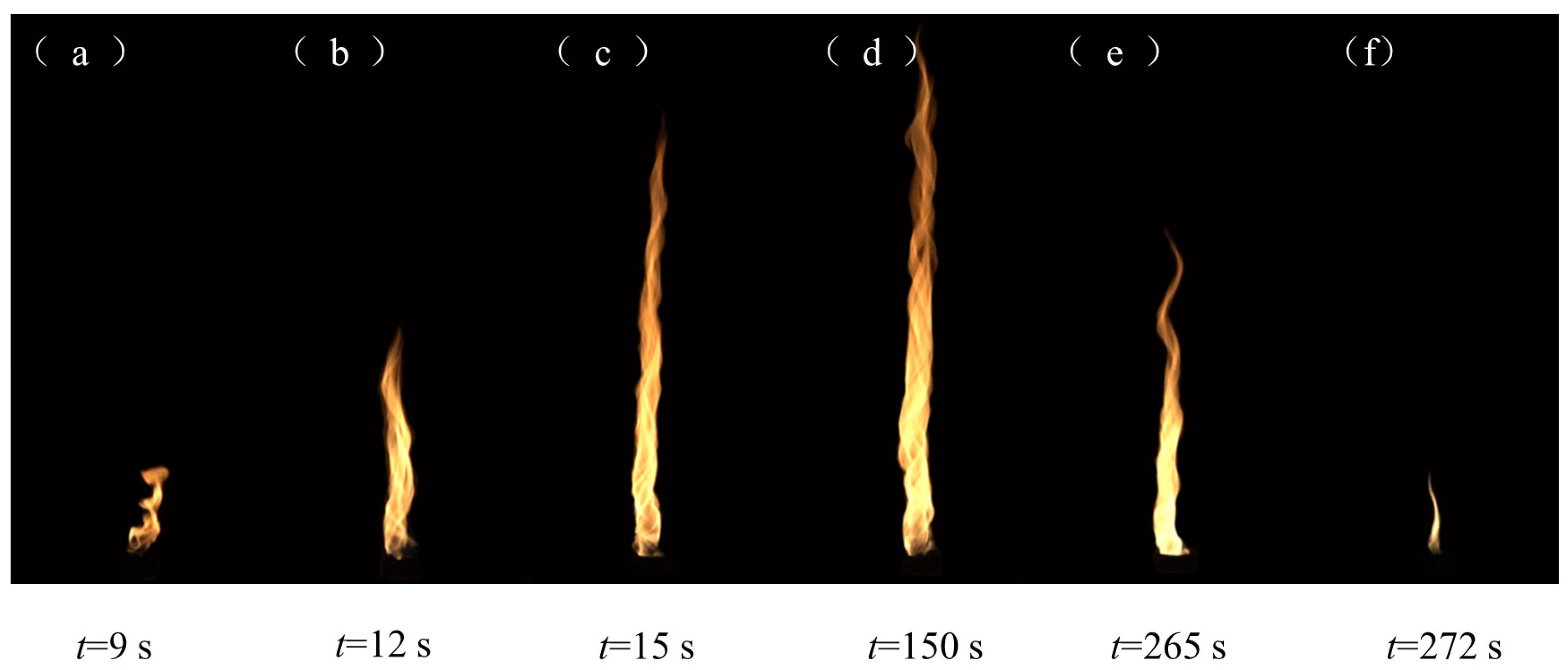
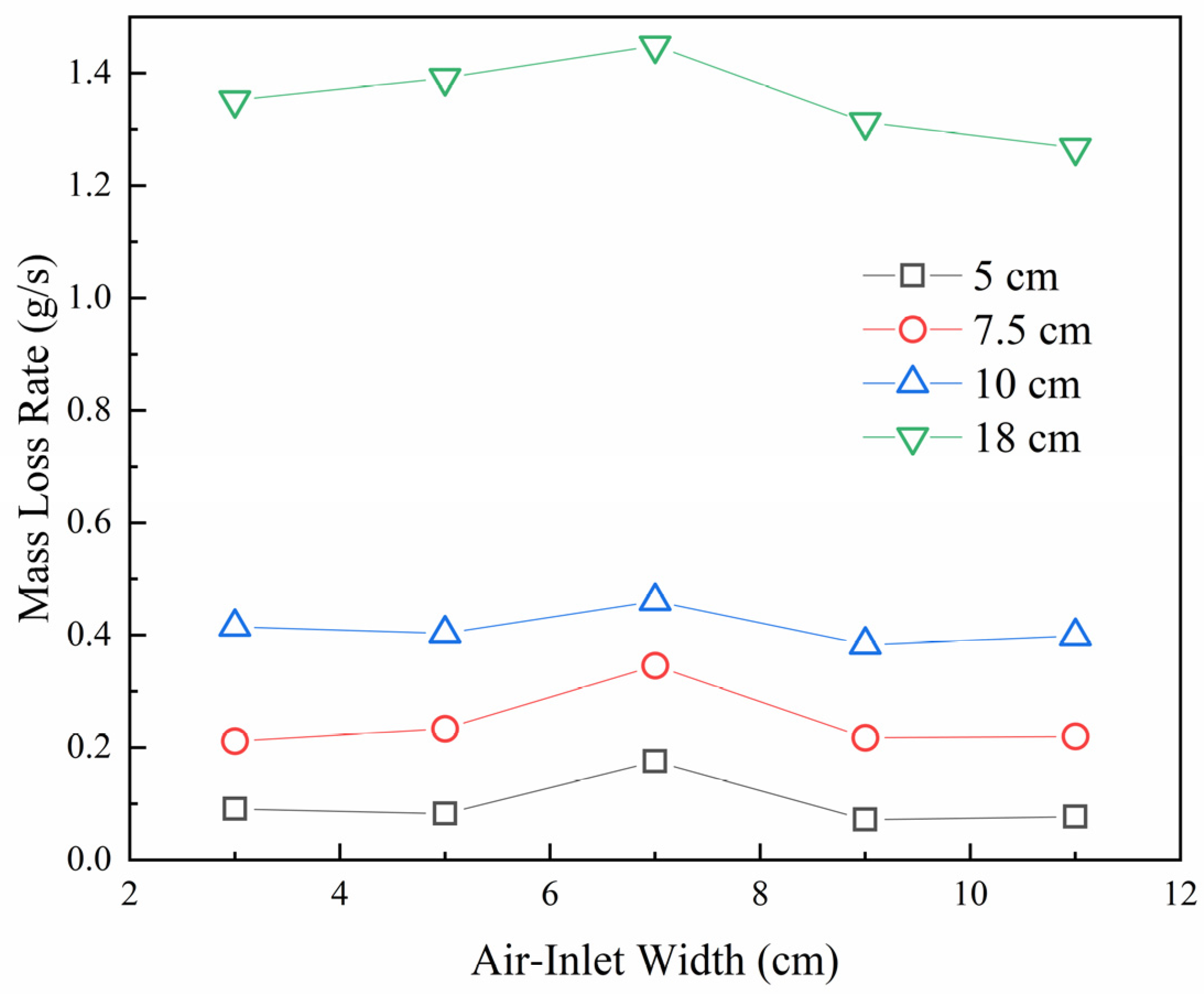

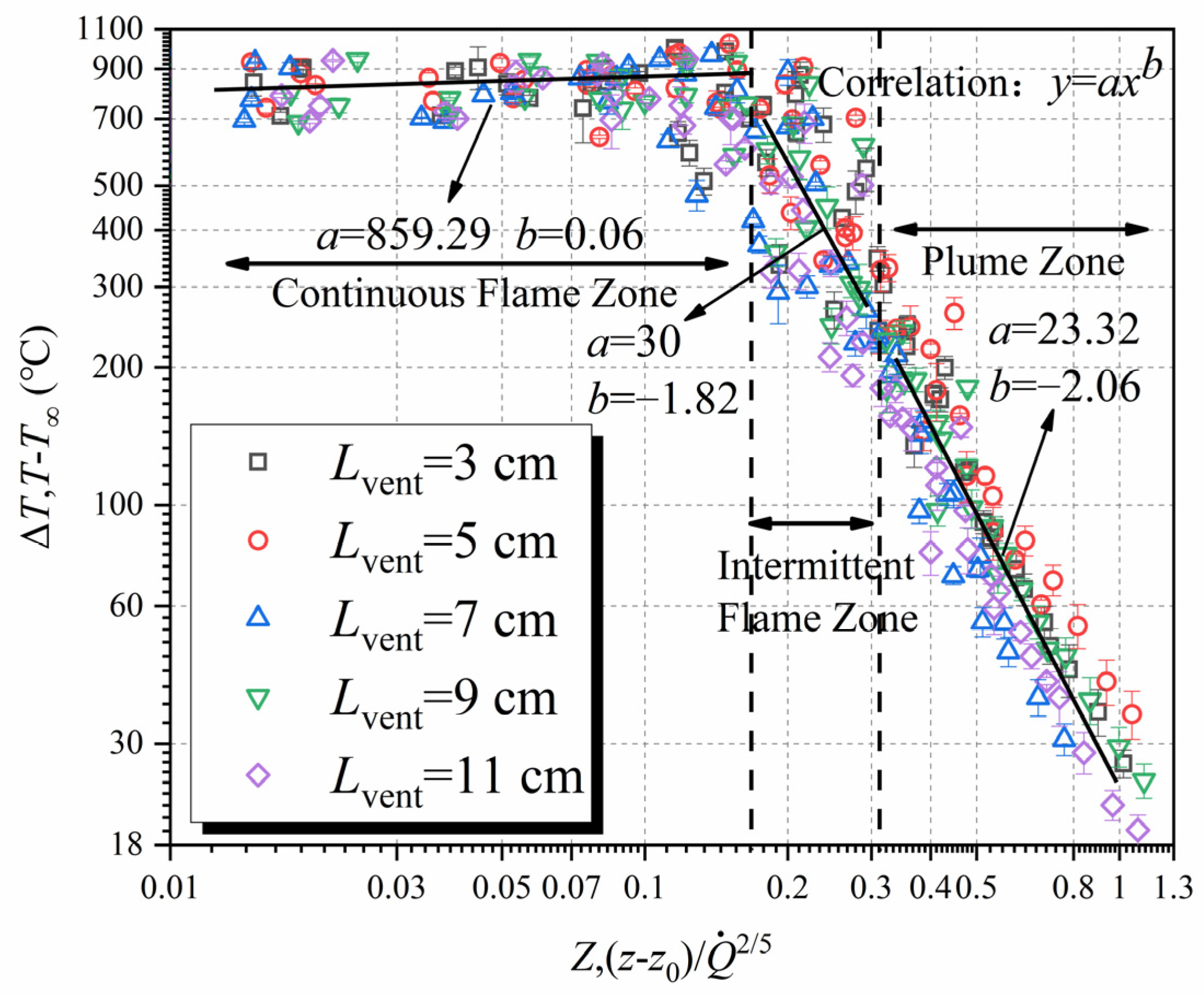
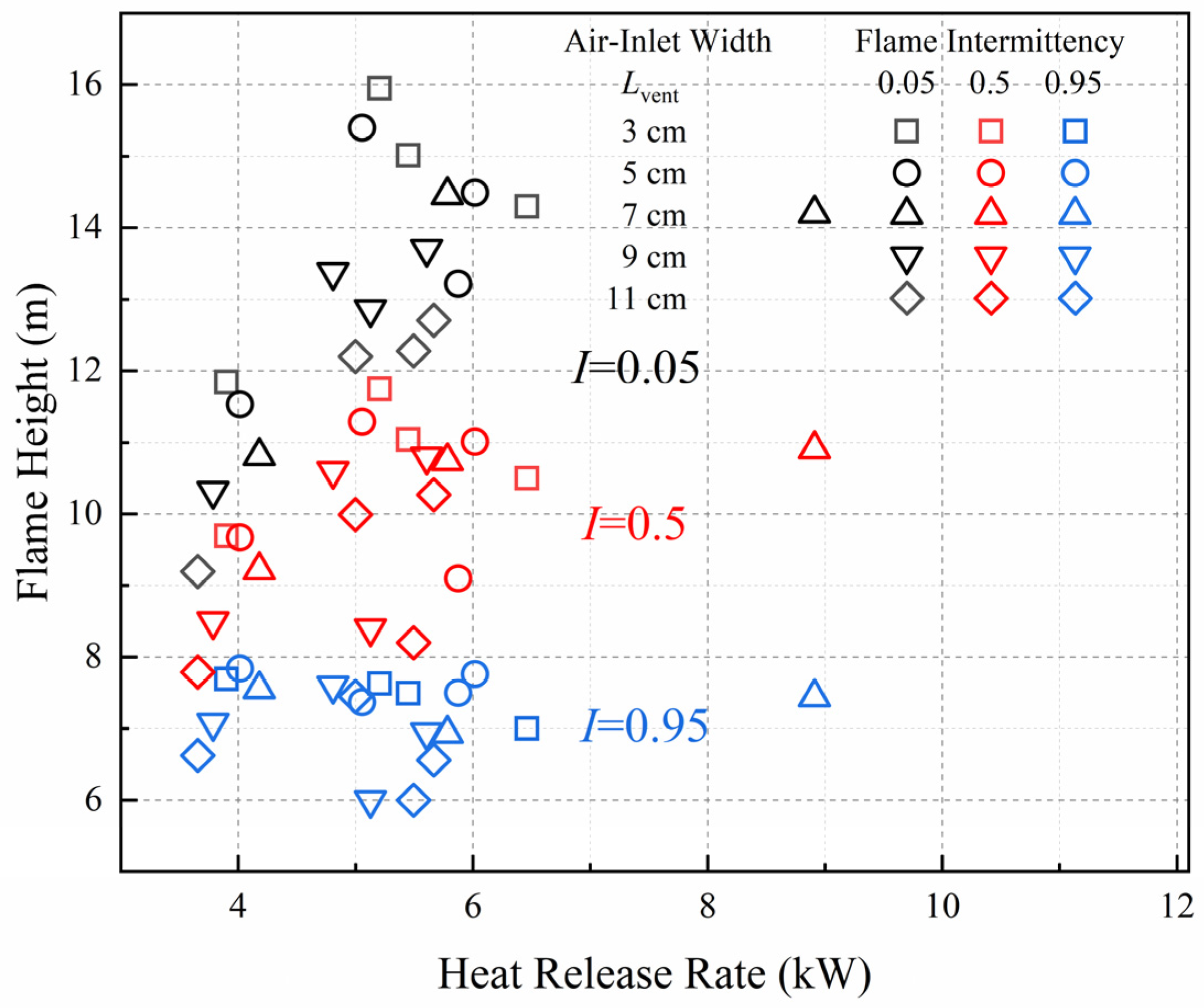

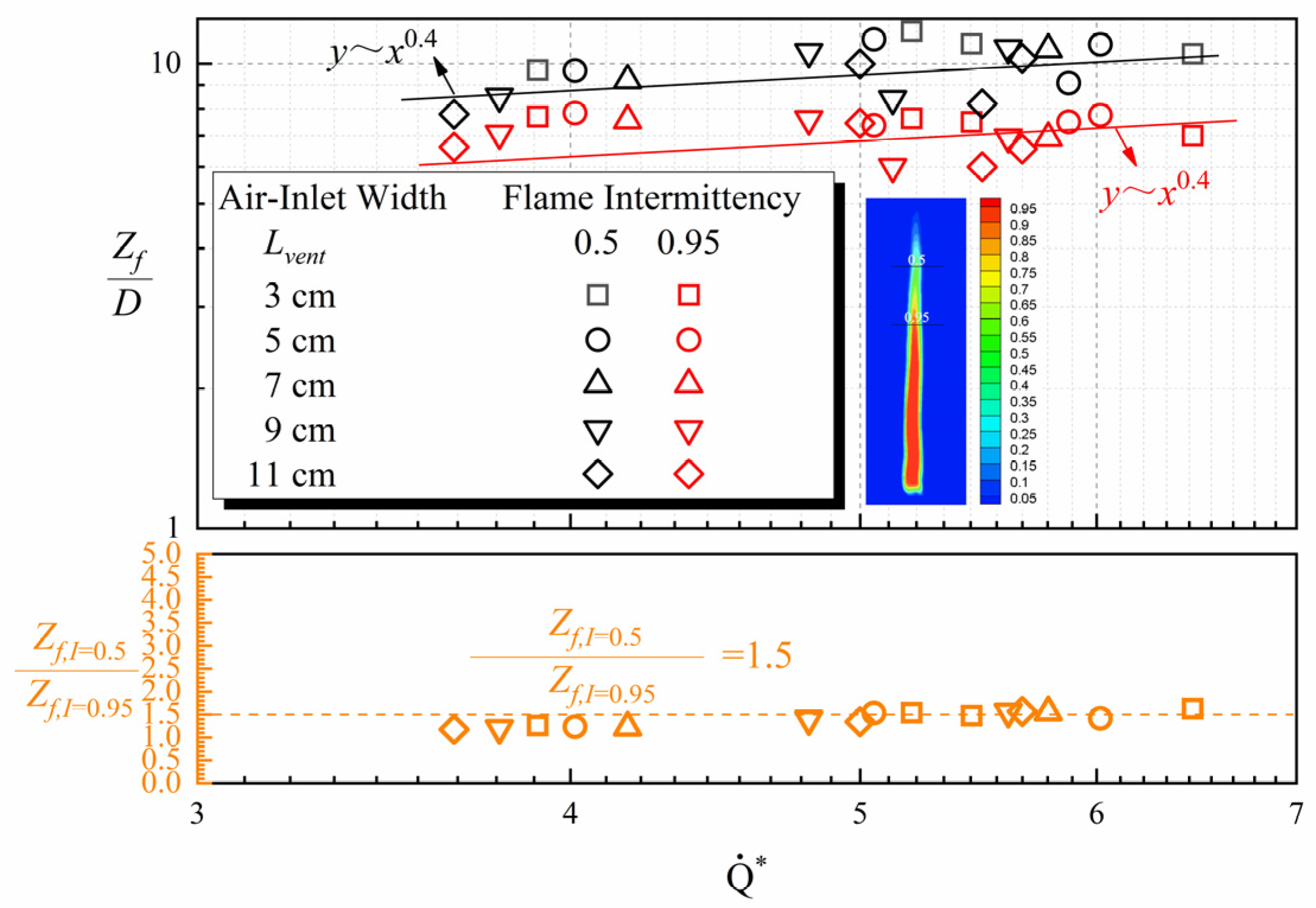
| Lvent | D | |||||
|---|---|---|---|---|---|---|
| (cm) | (cm) | (kW) | (m) | (m) | (m) | |
| 3 | 5 | 3.73 | 6.46 | 0.72 | 0.53 | 0.32 |
| 7.5 | 8.68 | 5.45 | 1.13 | 0.83 | 0.56 | |
| 10 | 17.01 | 5.20 | 1.60 | 1.18 | 0.76 | |
| 18 | 55.43 | 3.90 | 2.13 | 1.75 | 1.39 | |
| 5 | 5 | 3.39 | 5.87 | 0.66 | 0.46 | 0.22 |
| 7.5 | 9.58 | 6.02 | 1.09 | 0.83 | 0.58 | |
| 10 | 16.53 | 5.05 | 1.54 | 1.13 | 0.74 | |
| 18 | 57.04 | 4.01 | 2.08 | 1.74 | 1.41 | |
| 7 | 5 | 7.20 | 12.45 | 0.65 | 0.45 | 0.26 |
| 7.5 | 14.19 | 8.91 | 1.07 | 0.82 | 0.56 | |
| 10 | 18.90 | 5.78 | 1.45 | 1.07 | 0.69 | |
| 18 | 59.41 | 4.18 | 1.95 | 1.66 | 1.36 | |
| 9 | 5 | 2.96 | 5.13 | 0.64 | 0.42 | 0.18 |
| 7.5 | 8.93 | 5.61 | 1.03 | 0.81 | 0.52 | |
| 10 | 15.72 | 4.81 | 1.34 | 1.06 | 0.76 | |
| 18 | 53.82 | 3.79 | 1.86 | 1.53 | 1.27 | |
| 11 | 5 | 3.18 | 5.49 | 0.61 | 0.41 | 0.20 |
| 7.5 | 9.03 | 5.67 | 0.95 | 0.77 | 0.49 | |
| 10 | 16.35 | 5.00 | 1.22 | 1.00 | 0.75 | |
| 18 | 51.96 | 3.66 | 1.66 | 1.40 | 1.19 |
Disclaimer/Publisher’s Note: The statements, opinions and data contained in all publications are solely those of the individual author(s) and contributor(s) and not of MDPI and/or the editor(s). MDPI and/or the editor(s) disclaim responsibility for any injury to people or property resulting from any ideas, methods, instructions or products referred to in the content. |
© 2023 by the authors. Licensee MDPI, Basel, Switzerland. This article is an open access article distributed under the terms and conditions of the Creative Commons Attribution (CC BY) license (https://creativecommons.org/licenses/by/4.0/).
Share and Cite
Ding, C.; He, L.; Yan, Z.; Li, Y.; Ma, S.; Jiao, Y. Experimental Investigation on the Impact of Varying Air-Inlet Widths and Fuel Pan Diameters on Fire Whirls’ Combustion Characteristics. Fire 2023, 6, 309. https://doi.org/10.3390/fire6080309
Ding C, He L, Yan Z, Li Y, Ma S, Jiao Y. Experimental Investigation on the Impact of Varying Air-Inlet Widths and Fuel Pan Diameters on Fire Whirls’ Combustion Characteristics. Fire. 2023; 6(8):309. https://doi.org/10.3390/fire6080309
Chicago/Turabian StyleDing, Chao, Lingfeng He, Zijian Yan, Yuyao Li, Shuangyang Ma, and Yan Jiao. 2023. "Experimental Investigation on the Impact of Varying Air-Inlet Widths and Fuel Pan Diameters on Fire Whirls’ Combustion Characteristics" Fire 6, no. 8: 309. https://doi.org/10.3390/fire6080309
APA StyleDing, C., He, L., Yan, Z., Li, Y., Ma, S., & Jiao, Y. (2023). Experimental Investigation on the Impact of Varying Air-Inlet Widths and Fuel Pan Diameters on Fire Whirls’ Combustion Characteristics. Fire, 6(8), 309. https://doi.org/10.3390/fire6080309







